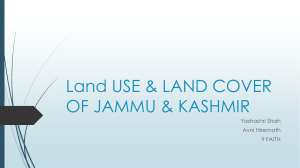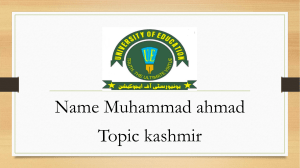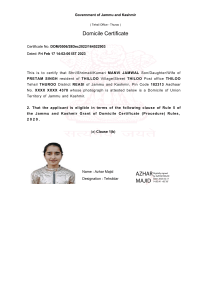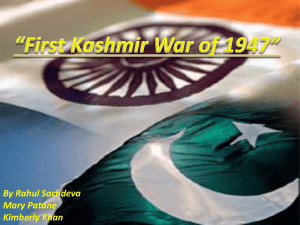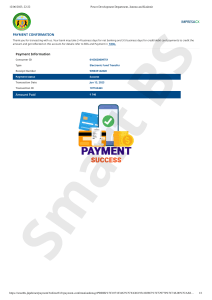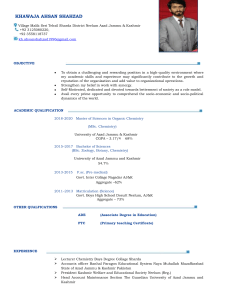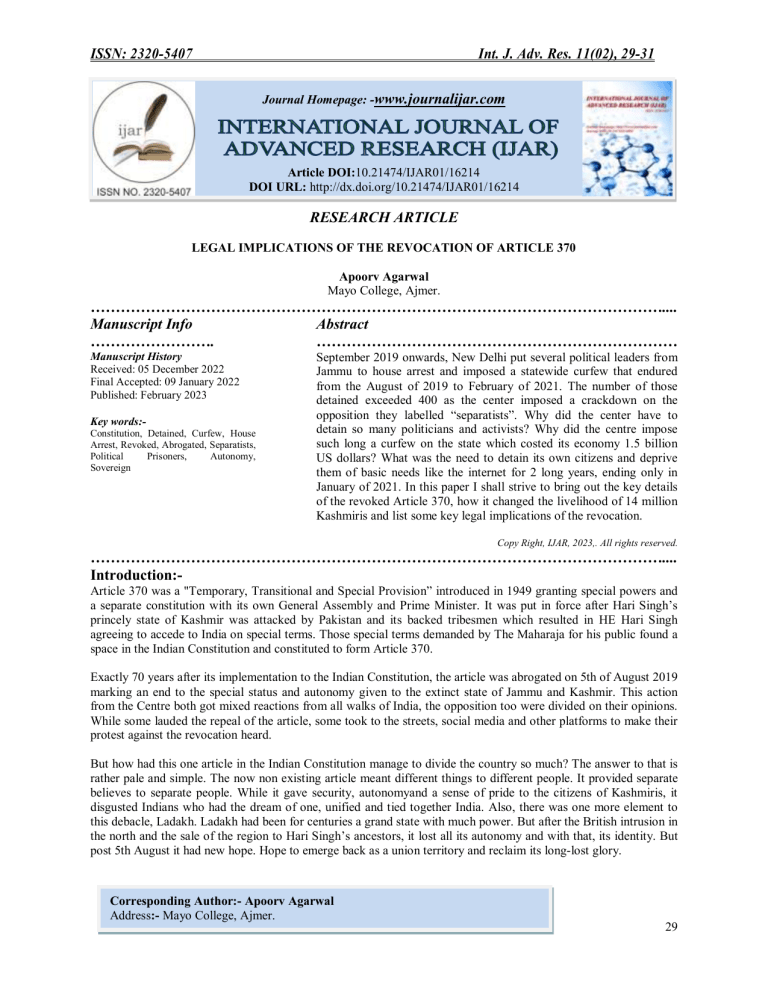
ISSN: 2320-5407 Int. J. Adv. Res. 11(02), 29-31 Journal Homepage: -www.journalijar.com Article DOI:10.21474/IJAR01/16214 DOI URL: http://dx.doi.org/10.21474/IJAR01/16214 RESEARCH ARTICLE LEGAL IMPLICATIONS OF THE REVOCATION OF ARTICLE 370 Apoorv Agarwal Mayo College, Ajmer. …………………………………………………………………………………………………….... Manuscript Info Abstract ……………………. ……………………………………………………………… Manuscript History Received: 05 December 2022 Final Accepted: 09 January 2022 Published: February 2023 Key words:- Constitution, Detained, Curfew, House Arrest, Revoked, Abrogated, Separatists, Political Prisoners, Autonomy, Sovereign September 2019 onwards, New Delhi put several political leaders from Jammu to house arrest and imposed a statewide curfew that endured from the August of 2019 to February of 2021. The number of those detained exceeded 400 as the center imposed a crackdown on the opposition they labelled “separatists”. Why did the center have to detain so many politicians and activists? Why did the centre impose such long a curfew on the state which costed its economy 1.5 billion US dollars? What was the need to detain its own citizens and deprive them of basic needs like the internet for 2 long years, ending only in January of 2021. In this paper I shall strive to bring out the key details of the revoked Article 370, how it changed the livelihood of 14 million Kashmiris and list some key legal implications of the revocation. Copy Right, IJAR, 2023,. All rights reserved. …………………………………………………………………………………………………….... Introduction:Article 370 was a "Temporary, Transitional and Special Provision” introduced in 1949 granting special powers and a separate constitution with its own General Assembly and Prime Minister. It was put in force after Hari Singh‟s princely state of Kashmir was attacked by Pakistan and its backed tribesmen which resulted in HE Hari Singh agreeing to accede to India on special terms. Those special terms demanded by The Maharaja for his public found a space in the Indian Constitution and constituted to form Article 370. Exactly 70 years after its implementation to the Indian Constitution, the article was abrogated on 5th of August 2019 marking an end to the special status and autonomy given to the extinct state of Jammu and Kashmir. This action from the Centre both got mixed reactions from all walks of India, the opposition too were divided on their opinions. While some lauded the repeal of the article, some took to the streets, social media and other platforms to make their protest against the revocation heard. But how had this one article in the Indian Constitution manage to divide the country so much? The answer to that is rather pale and simple. The now non existing article meant different things to different people. It provided separate believes to separate people. While it gave security, autonomyand a sense of pride to the citizens of Kashmiris, it disgusted Indians who had the dream of one, unified and tied together India. Also, there was one more element to this debacle, Ladakh. Ladakh had been for centuries a grand state with much power. But after the British intrusion in the north and the sale of the region to Hari Singh‟s ancestors, it lost all its autonomy and with that, its identity. But post 5th August it had new hope. Hope to emerge back as a union territory and reclaim its long-lost glory. Corresponding Author:- Apoorv Agarwal Address:- Mayo College, Ajmer. 29 ISSN: 2320-5407 Int. J. Adv. Res. 11(02), 29-31 How Did The Centre Manage To Repeal Article 370? As part of the negotiations with the Maharaja in 1949, for any amendments made to the article 370, the concurrence of the Constituent Assembly of Jammu And Kashmir as well as the President (Presidential Order C.O. 272 as instructed by Article 367) was required. But the Constituent Assembly itself dissolved itself on 26th January 1957, without making or suggesting changes to the Article. This absence of the Constituent Assembly was the root of the long-standing debate arguing whether the Article was now permanent part of the Indian Constitution and was a revival of the Constituent Assembly necessary for the amendments and abrogation of the Article or better still, can the Article be repealed or amended through the normal amending procedure under the Constitution. The President being a representative of the Centre, and now being the only one with power in terms of the Article, the Centre time and again used the President‟s office‟s powers to make amendments to the Article and subsequently reducing the autonomy of the state. Throughout several past decades the governments in office including the incumbent BJP lead NDA government exploited the Presidential Order C.O. 272 while imposing Presidential rule or order 47 times. Legality Of The Move The legitimately of the abrogation of the „Special Status‟ by the center is heavily controversial and highly debated. While some constitutional experts call this move legal and “constitutional sound” as stated by renowned commenter Subhash Kashyap, many others called it a sly action. As the Lok Sabha was consulted and was the one to vote on the motion and not the not existing Constitutional Assembly of Kashmir as agreed with Maharaja Hari Singh of Kashmir. Critics thus have also called the move as “breaching the contractual basis upon which the Maharaja of Kashmir agreed to join the Republic of India in 1947”. Experts suggest this could take an international move too. Constitutional law expert Faizan Mustafa commentates that the 1947 agreement under which Kashmir decided to accede to India was one between two „sovereign states‟, calling it especially an international treaty. Based on this many lawyers opposing this revocation called for this case to be heard and handled by the International Court of Justice. The ICJ though has offered a „non-binding advisory opinion‟ citing the Indian Government won‟t anyway accept ICJ‟s jurisdiction. What Changed In The Valley It‟s been 2 years since the abrogation of the Article 370, for good or bad, depends on who you ask. But since the 2 years of its exclusion from the constitution, a lot has changed for everyone residing in the now union territories of Jammu and Kashmir and Ladakh. The political scenario has drifted quite drastically with the formation of the formation of new alliances and the breaking of older ones. While some sections of society have seen more freedom, others have been burdened under the freedom awarded to others. The hopes of an Azad Kashmir have been quashed for the nationalists and separatists and BJP has finally gotten its way after decades of protests and demands which even saw the death of its leader Syama Prasad Mookerjee while in custody of the Kashmiri executive force. Listing some of the changes post 5th August 2019, we think of the women, who while the Article was in force if were to marry a non-resident man were not allowed to inherit their ancestral property neither buy other properties. Speaking of properties, in the erstwhile state of Kashmir, no foreigner of the state was allowed to own/buy properties in the state as a means of land security for the locals. But now the article which gave security of land to the locals is abolished along with the security of land has gone the security of government jobs. Prior to the revocation, it wasn‟t permitted for a non-resident to give exams for government jobs and apply for government positions. Now any man from India can both own properties anywhere in Jammu & Kashmir and apply for positions in the government. As the abrogation of the Article greatly disempowers the common Kashmiri, the People‟s Conference remarked that 5th of August will be remembered as a “day of disempowerment” in the history of Jammu and Kashmir. The list of despondents of Kashmir‟s autonomy and social security doesn‟t end there. The Centre has also labelled the Kashmiri State flag and Kashmiri Constitutional illegitimate. Along with the Constitution, has gone the state‟s own penal code, The Ranbir Penal Code. All 3 which was awarded to the state with the Article has now been taken away from the State. Instead of the State Flag, the Indian Tricolour or the Tiranga now flies over all government buildings in the Union Territory. The political spectrum there too came together to fight the Centre lead by BJP challenging it to get back the special status for the state. In the valley political rivals National Conference and People‟s Democratic Party came together forming the Gupkar Alliance, which the people called the Kashmiri Mahagathbandhan. National Conference leaders 30 ISSN: 2320-5407 Int. J. Adv. Res. 11(02), 29-31 Farooq Abdullah and Omar Abdullah, and PDP leader Mehbooba Mufti, joined hands and held meetings after their release in 2020 from house detention in August 2019. In observance of the other smaller amendments made in the state, the Centre has decided not to issue passports or provide other government services to residents having any role in separatist or anti-India activism such as stone pelting or other subversive acts. Conclusion:It‟s been merely a year since the curfew in Jammu and Kashmir was lifted but normalcy in the union territory is rather uncertain. While the number of police/army involvement with roadblocks, bunkers and checkpoints have reduced since the end of curfew, the sense and demand for statehood and special rites for the former state remains alive and active among the residents in the valley. The gravity with which the Centre took the decision has left deep scar in all of Kashmir. The nullification of Article 370, repeal of 35 (A), bifurcation of the state and the enactment of of the new domicile laws seemed to have increased the all-pervasive sense of fear, humiliation and hopelessness among the Kashmiri population. People are still in shock and seemed psychologically disturb showing heightened anxiety and paranoia about the future. With virtually no business and tourism in the region for almost 2 years, the economy reached a rather low point amounting to an estimated loss of 1.5 billion USD. The businesses now are trying to open up and make up for the losses of the past 2 years. As the tourism gets back on tracks, hotels and shops are opening up providing again a new hope for economic development. As for the future of India in general, until New Delhi adopts an iron fist policy over its states and have controlling powers over them, we are likely to see many such incidents in the future. With much possibility we are bound to see disturbance and political upheaval in The North-East where just like Jammu And Kashmir, they too have special rites bestowed upon them by the Centre under Article 371. But until then, India is very much in danger of facing separatist movements by separatists of Kashmir, the Naxals of the tribal belt, or the tribesmen of North-East. Bibliography:The Following sources have been used to gather information and facts for the complied report: 1. https://loksabha.nic.in/ 2. https://www.jk.gov.in/jammukashmir/ 3. https://www.firstpost.com/ 4. https://www.indiatoday.in/ 5. https://www.hindustantimes.com/ 6. https://government.economictimes.indiatimes.com/ 7. https://www.dw.com/en/ 8. https://timesofindia.indiatimes.com/ 9. https://www.parliament.uk/ 10. https://indconlawphil.wordpress.com/2019/08/05/the-article-370-amendments-key-legal-issues/ 31 Manuscript No.: IJAR-42027 Date: 31st Jan 2023 Title: Legal Implications Of The Revocation Of Article 370 DR.P.MALYADRI 31st Jan 2023
